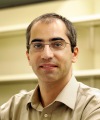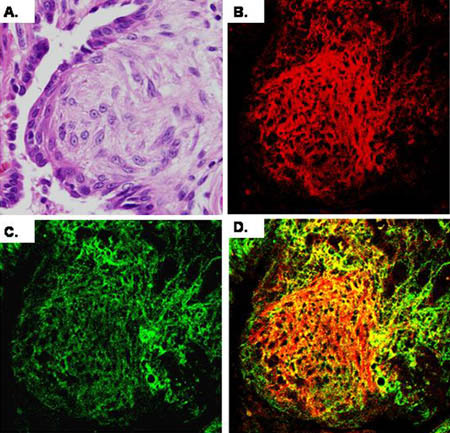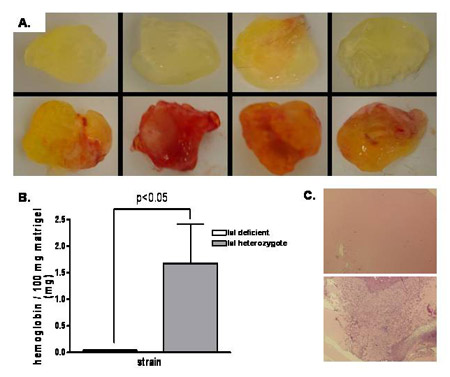 |
|
Cell-Matrix Interactions Stavros Garantziotis, M.D.
Principal Investigator Tel (919) 541-0133 Fax (919) 541-4133 garantziotis@niehs.nih.gov Curriculum Vitae (http://www.niehs.nih.gov/research/atniehs/labs/lrb/matrix-bio/docs/garantziotis-cv.pdf) Mail Drop E1-03 Research Triangle Park, North Carolina 27709 Delivery Instructions Research SummaryThe Matrix Biology Group studies cell-matrix interactions in the pulmonary response to environmental or alloimmune lung injury. The group has identified novel interactions and functions for a serum protein, called inter-alpha-trypsin inhibitor, which can bind to extracellular components such as complement, hyaluronan and other extracellular matrix (ECM) elements. These interactions influence the development of inflammation, angiogenesis, and re-epithelialization after injury. Research performed by the Matrix Biology Group will expand these findings and investigate the framework in which ECM can influence the cellular response to environmental injury.  Fibroblastic focus in pulmonary fibrosis. A) H&E stain B) IαI C) hyaluronan D) IαI and hyaluronan colocalize.
 (A) IαI deficiency (top) inhibits angiogenesis in the matrigel model. (B) and (C) show matrigel Hgb content and histology.
ECM and cells are in a constant feedback relationship during development and in the tissue response to injury. Cells actively modify their pericellular matrix in the course of their development, differentiation and migration. On the other hand, ECM can be directly altered through environmental stimuli, and the matrix milieu affects cell behavior, phenotype and survival. The group investigates this relationship—particularly the role of the ECM component hyaluronan—in relation to the pulmonary response to environmental injury. Hyaluronan is one of the most abundant ECM glycosaminoglycans, and depending on its size, can affect cell development, scar formation, angiogenesis and inflammation after injury. A serum protein, inter-alpha-trypsin inhibitor is necessary for optimal hyaluronan binding to its cellular receptors. The group discovered novel interactions of human inter-α-inhibitor (IαI) with extracellular molecules. For example, IαI can interact with complement and inhibit complement activation and complement-induced lung injury. Furthermore, the lab is investigating the role of IαI-hyaluronan binding in different models of inflammation and lung injury. Preliminary data indicates that IαI and hyaluronan co-localize in fibrotic lungs (Figure 1). Furthermore, IαI is important for the angiogenic response to hyaluronan (Figure 2). The Matrix Biology Group is currently investigating the role of IαI, hyaluronan and other ECM components in angiogenesis and epithelial cell survival. The group utilizes mouse models of disease, including fibrosis, environmental asthma and alloimmune lung injury, as well as molecular biology tools for its investigations. Eventually, the lab hopes to translate its findings into human disease treatment, utilizing the new Clinical Research Unit located at the NIEHS. Major areas of research:
Stavros Garantziotis, M.D., obtained his medical degree at the Albert Ludwigs University in Freiburg, Germany, in 1994. After an internship in Internal Medicine at the University Hospital in Munich, Germany, he completed his residency in Internal Medicine at the Albert Einstein College of Medicine of Yeshiva University in New York, New York, and received his Board Certification in Internal Medicine in 1999. During 1999–2004, he completed a fellowship in the Division of Pulmonary, Allergy and Critical Care Medicine at Duke University Medical Center, and remained a faculty member in the Division until 2007. He received Board Certification in Pulmonary Medicine in 2003 and Critical Care Medicine in 2005. Clinically, Garantziotis was active in the field of lung transplantation and pulmonary fibrosis, both in the inpatient service as well as in the pulmonary clinic. In August 2007 Garantziotis joined the NIEHS as a member of the Laboratory of Respiratory Biology and as a Staff Clinician in the Clinical Research Unit. His clinical responsibilities included setting up and supervising the new Clinical Research Unit (CRU). |
|

